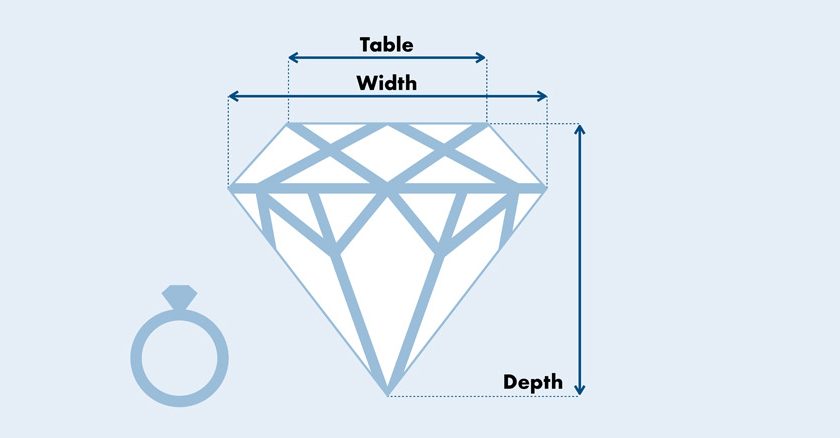Want to have a diamond with the best cut quality possible? Pay attention to its depth and table! Not only do these aspects contribute to your stone’s elegant shape, but they also play a huge role in creating the epic sparkle we’re sure you love. Want to know more about the table and depth of diamonds?
Read on…
Before we get into the nitty and the gritty, let’s first discuss the basics – What is a gemstone’s cut? One of the four Cs of diamonds, this feature refers to the arrangement of facets within a stone. It determines how different facets interact with light and, as touched upon previously, directly impacts the gem’s shine.
So, What Do We Mean By the Depth of Diamonds?
A diamond’s depth is essentially its height. It is the measurement of the distance from the stone’s table to its culet (the diamond’s pointed tip). Grading reports usually present the same in two ways:
- Total depth or depth percentage
- The actual depth in millimeters
What Is a Diamond’s Table?
Simply put, a diamond’s table refers to the flat, square-shaped facet present on top of the same. Here, the physical size of the facet differs from gemstone to gemstone based on their overall sizes. Because of this, experts typically measure the table percentage when grading the stone.
How Does the Depth and Table Affect a Diamond’s Brilliance?

• Depth
Believe it or not, the depth of a gemstone can impact its brilliance and beauty in a very prominent way. This is simply because it determines the overall proportions of the gem, thereby, directly impacting how light reflects off its facets. Here, if the wrong proportions are used and…
The gemstone is cut too deeply…
It can result in the appearance of unappealing visual characteristics such as dark-looking nailheads, for example. These can greatly reduce the sparkle of the gemstone. It could also make the stone look smaller than other diamonds of the same carat weight.
Alternatively, if the cut of a diamond is too shallow…
Light will pass through it instead of being reflected off its facets. What’s more, this type of cut could also result in the creation of the fish-eye effect that is unpleasing to look at.
Additional Definitions:
1. Nailheads
This visual effect typically occurs when a stone is cut too deeply. Here, instead of reflecting off your eyes, the light reflects off the bottom of the gem at an obscure angle. This results in the appearance of a dark, round shape (similar to that of a nail head) at the center of the stone.
2. Fish-Eye
Contrary to the above, this outcome occurs when the diamond’s cut is too shallow. When this happens, the internal reflections of the stone’s girdle can sometimes be seen within its table facet. This image appears in the form of an unpleasant fish-eye-like gray ring that greatly dampens the beauty of the stone.
• Table
Like its depth, a diamond’s table facet can also impact its sparkle and beauty. Here, this facet plays a huge role in refracting the rays of light that enter the gemstone and redirecting them to the other facets present on/within the same.
Of course, proportions are everything when it comes to this aspect of the diamond’s cut.
If the table facet is too big…
The upper facets of the stone (which are present on the crown) may not have enough space to disperse light.
If the table facet is too small…
It could prevent a large amount of light from entering the stone, thereby, resulting in a relatively dull gem.
Now that you know the basics of the depth and table of a diamond, let’s move on to the next segment.
How Do You Find the Depth and Table Percentage?
Believe it or not, when the depth and table of a gemstone are correctly proportioned, the resultant sparkle is exquisite. And that’s why it’s important to know the ideal percentages of the same. But before we tell you about that, here’s how you can accurately calculate the depth percentage and table percentage:
- Total depth or depth percentage – Divide the total height of the diamond by its total width.
- Table percentage – Divide the width of the table by the width of the diamond.
What Are the Ideal Depth and Table Percentages for a Round Diamond?
The ideal round diamond table and depth percentages are as follows:
- Depth Percentage – 59 to 62.6%
- Table Percentage – 54 to 57%
Please note:
The ideal depth and table percentages for one diamond shape may not be the best percentages for another shape. Want to know about the ideal percentages for other shapes and cuts? Read the next segment.
Ideal Depth and Table Percentages for Diamonds of Different Shapes
Mentioned below is a list of the most popular diamond shapes and cuts along with their best diamond depth and table percentages:
| Shape/Cut | Ideal Depth Percentage | Ideal Table Percentage |
| Cushion Cut | 61 to 68% | < 68% |
| Asscher Cut | 61 to 68% | 60 to 68% |
| Pear Shape | < 68% | 53 to 65% |
| Heart Shape | 56 to 62% | 56 to 62% |
| Princess Cut | 68 to 74% | 69 to 75% |
| Emerald Cut | 61 to 68% | 60 to 68% |
| Oval Shape | < 68% | 53 to 63% |
| Radiant Cut | < 67% | 61 to 69% |
| Marquise Cut | 58 to 62% | 53 to 63% |
We hope you’ve noted down the ideal depth and table percentages of diamonds depending on their shapes and cuts. Let’s move on to the next segment.
Now, let’s take a look at lab-grown diamonds. Just like natural diamonds, the lab-grown diamond depth refers to the measurement of its height from the culet (bottom) to the table facet (top). It is an important characteristic that affects the overall appearance and brilliance of a lab-made diamond.
The depth percentage of a lab-grown diamond can vary. Different depth ranges are considered favorable for optimal light reflection and brilliance. Typically, depth percentages between 57% and 65% are considered ideal for round brilliant-cut lab-grown diamonds.
To understand and compare various depth percentages, a lab-grown diamond depth table is often used. This table provides a range of acceptable depth percentages for different diamond shapes and sizes. It helps diamond cutters and gemologists determine the ideal depth percentage based on the diamond’s other characteristics.
What Else Should You Keep in Mind When Buying a Diamond?

Needless to say, the cut of a diamond isn’t the only thing that impacts its beauty. The other 3Cs matter as well. Noted below is a little more information about the same.
1. Clarity
Fun Fact: As they are created under extreme heat and pressure, the majority of natural diamonds present today tend to feature different types of clarity characteristics. These can appear both internally (inclusions) and externally (blemishes).
The term ‘clarity’ refers to the absence of these characteristics. Needless to say, the better the clarity of a stone here, the more brilliant and appealing it will be.
To measure this aspect, graders generally evaluate every stone that comes their way and place them on the clarity chart based on their clarity level. Currently, this chart consists of 11 grades ranging from FL (Flawless) to I (Included).
Our Recommendation:
While FL diamonds are undoubtedly the most brilliant of the lot, it is worth noting here that they are also extremely rare and expensive. As such, if you’re working on a tight budget, we suggest opting for a stone with a VS1 (Very Slightly Included – First Degree) clarity grade or higher.
2. Color
At Angara, we like to believe that a diamond is only as spectacular as its color (or lack thereof). And this opinion is wonderfully reflected in this gemstone’s color grade. Unlike other colored gemstones, white diamonds are typically valued based on how closely they appear to be colorless. Depending on the same, these stones are generally placed on a color scale that constitutes 23 grades ranging from D (colorless) to Z (yellow or brown).
Our Recommendation:
If you’re looking for the best of the best and have the money to splurge on the same, then a D-graded diamond is the way to go. Having said that, if you’re a babe on a budget, then we suggest opting for a gem that features an H color grade or higher. This is simply because the gemstones that fall within this category showcase minute traces of color that are practically invisible to the naked eye.
Also Read: Diamond Color vs. Clarity – Which Is More Important?
• Carat Weight
Last but not least on this list is the diamond’s carat weight. As indicated by its name, this refers to the measure of the stone’s size/weight. If you would like to learn about this topic in detail, we suggest reading our in-depth article dedicated to the same.
Our Recommendation:
Honestly speaking, there’s really no right or wrong answer here and the same depends on your budget. That being said, if you want to get the most bang for your buck, we suggest opting for slightly lower color and clarity grades (as mentioned above) and allocating more of your budget toward the carat weight and cut of your stone.
Want to know a little more about the diamond grading process and understand how the 4Cs (Cut, Color, Clarity & Carat) impact the gemstone’s position on the grading scales? We recommend reading our article about the same.
Now that you know everything there is to know about the diamond depth and table as well as the other 3Cs of the diamond, let’s move on to the next segment.
Did You Know?
- Even though white diamonds are the most preferred choice, this stunning gemstone can actually be found in a multitude of hues, such as blue, green, pink, orange, etc. Currently, yellow and brown diamonds are the most common of the lot.
- The Uncle Sam diamond is considered to be the largest diamond ever found in the U.S. to date. This gorgeous stone (which was discovered in 1924) weighs an eye-widening 40.23 carats. It was unearthed in the Crater of Diamonds State Park (which happens to be the only diamond mine open to the public). Surprisingly, since 1906, over 75,000 diamonds have been discovered in this park.
Angara Says:
Interested in buying diamond jewelry but can’t find a reliable seller? Look no further than our online store. From diamond engagement rings to diamond earrings, we’ve got everything you need to have an absolutely stunning 2023. What’s more, every jewelry piece in our collection comes with a certificate of authenticity, so you’ll never have to worry about your purchase.
About to take your relationship to the next level? Check out our collection of lab-grown diamond engagement rings and find your token of love. For a pop of color, you can shop for lab-grown engagement rings adorned with lab-created rubies, blue sapphires and emeralds.
You can also use our easy customization option to design the diamond jewelry of your dreams. All you need to do is choose the gemstone quality, carat weight and metal according to your preference and budget.
Diamond Depth and Table
- Which diamond cut is considered to be the best?The round brilliant is the best cut for a diamond. Featuring a whopping 58 facets, this cut is specially created to enhance the brilliance, sparkle and overall beauty of the gem.




























